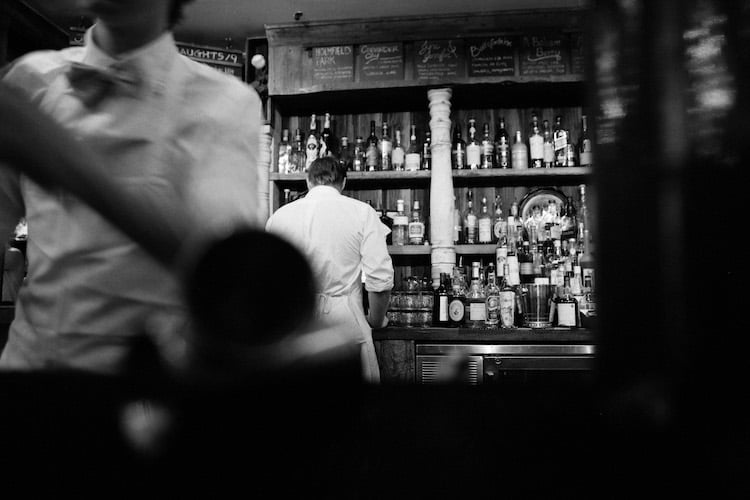What Is The Average Product Mix Of Food And Alcohol In A Full Service Restaurant
Average Restaurant Costs: Liquor, Food, and Labor

// By Jordan Brydges // , Oct ii, 2019
Topics: Liquor Cost
There are many costs that go into running a eatery and while some are not controllable, others are, and taking advantage of lowering those costs volition lead to a successful business concern. The costs that are easiest to control in a restaurant include, or what some telephone call "The Big Three": We volition go over each in more than detail and the industry averages and show yous how to summate them so you can run into how your costs are impacting your concern. The sum of your Cost of Goods Sold (COGS) for nutrient and potable and labor costs is chosen your prime number costs. These costs include food and beverage inventory, labor, payroll taxes, any workers' bounty, medical insurance, and employee benefits. Your prime costs will give y'all an indication of how much y'all should charge in order to say assisting and how much you can spend without running yourself into debt. Total COGS + Total Labor = Prime Costs Just in example you lot forgot how to calculate COGS here is the formula: Showtime Inventory + Purchases - Ending Inventory = COGS Beginning Inventory = the amount of nutrient and beverage you lot started with on your shelves for a certain period. Purchases = the amount of food and drink you bought for a certain flow. Ending Inventory = the amount of food and potable left over for a certain period. Yous will likewise want to compare your prime costs to your total sales to see if yous are within a healthy range. Prime Cost as Per centum of Sales = Prime number Cost/Total Sales Ideally you would want your prime costs to be between 55-65% and the remainder goes to other expenses like rent, new equipment, utilities and menu design. Annihilation less than 50% can bespeak your nutrient quality is low, you are charging too much, or accept too little staff. On the other manus, annihilation over lxx% makes it hard to be profitable considering yous only have 30% to go to your other expenses such as rent, insurance and utilities. For example, say your labor costs were $4,000 for a given flow and your nutrient and potable COGS were $viii,000. Your prime costs would be $12,000. (4,000 + 8,000) = $12,000. Now say your total sales for the period were $nineteen,000. Your prime cost equally a percentage would exist 63% (12,000 / xix,000 x 100) = .63 or 63%. 63% is in the platonic range for a prime price percentage and this means yous accept 37% that can be allocated for hire, utilities, insurance and other expenses and also profits. Now that we've gone over how much your prime costs should ideally be, we can dive in and see what the typical costs are for liquor, food, and labor for a eating place or bar. Plainly every bar and eating place would love to keep their liquor costs as low as possible, because the lower the liquor costs, the greater the profits. Your liquor costs are based on your straight costs and gross margin and every place has different costs to take into account that volition affect liquor costs. The industry average for total beverage programs is between 18-24%. Every drink type has a different cost percent as well. Liquor is about 15%, typhoon beer about twenty%, bottled beer around 25%, and wine can exist upwards of 30-forty%. To calculate your liquor costs, you want to have your Cost of Goods Sold and separate by total sales. COGS/Liquor Sales = Liquor Costs For example, if for the year your bar sold $15,000 of liquor inventory and information technology generated sales of $65,000 then your liquor cost percentage would be 23%. Then every dollar in sales means 23 cents is used to pay for the liquor and the other 77 cents is your gross margin. Remember that gross margin is the amount of sales acquirement after taking out the costs to produce the detail. (15,000/65,000) = .23 10 100 = 23% Considering of slim margins, controlling food costs is i of the biggest challenges for eatery operators. By monitoring these costs closely you lot volition know when to accommodate prices, purchase different products or quantities, or change distributors. Typically the average food costs are around 28-35% to remain profitable. Your COGS for nutrient is the amount you lot spend on ingredients for each dish and inventory for a given time flow. To calculate bodily nutrient costs utilize the following formula: Food Cost Percent = Beginning Inventory + Purchases - Ending Inventory / Food Sales For instance, permit's say you had $eight,000 in beginning inventory, purchases of $1,500 and an ending inventory of $7,500 and $vi,000 in sales for a given menstruation. You would have a food cost of 33% and then for every dollar in sales it costs you 33 cents. ($8,000 + one,500) - seven,500 / 6,000 = .33 x 100 = 33% Anyone can add together upwards food costs, but without comparing it to something what does it fifty-fifty mean? Looking at your ideal food costs tin bear witness you any inconsistencies between your food cost percentage and your actual food cost. Dissimilar bodily food costs, ideal nutrient costs practice not consider beginning and ending inventories, but looks at total costs and sales. The formula for ideal nutrient costs is: Ideal Food Cost Percentage = Total Price Per Dish / Full Sales Per Dish For instance, say your total toll per dish is $1,500 and total sales per dish is $6,000. Your platonic food cost per centum would be 25%. ($i,500 / 6,000) = .25 or 25% So looking at the ideal food cost percent and the actual food cost per centum we can see in that location is a eight% difference (33% - 25%). This percentage departure can come up from nutrient waste or over ordering, which now that we know this we can take steps to reduce costs. First of all, what is labor cost? You might exist thinking information technology is only your hourly wages and salaried employees, only there is more to it. Labor costs are annihilation that is labor-related and include: A good rule of thumb is to aim to go along labor costs between xx-thirty% of gross acquirement. With that being said, every institution is dissimilar and sometimes yous require more staff on paw than usual that might increase your costs and other times you are able to cut staff to reduce labor costs. A fast-food restaurant could typically run labor costs effectually 25% while a total service restaurant could run near 30-twoscore% of revenue depending on how up scale the bar or eating place is and the demand needed. In club to determine what your eatery is running at for labor costs y'all will need to calculate labor costs equally a percentage. The first affair you volition want to practise is add together up the cost from the different toll groups. For example let's say your labor costs are equally follows for a given year: Looking at the total labor costs doesn't tell u.s.a. much until we convert it to a per centum of sales. There are two ways to go about this. This first is by calculating labor costs as a percentage of total sales and the other as a percent of operating costs. Total Labor Costs/Total Sales First yous will desire to collect your full revenue information from your income argument or POS organization written report. For example permit'south assume your sales for the year were $900,000. Adjacent, you will want to calculate your total labor costs by calculation upwards all the categories. We volition utilize the number from above of $237,000. Y'all volition so use the formula and separate labor cost by revenue. Your labor costs would be 26% of your sales, which is right inside the manufacture average. $237,000 / 900,000 x 100 = .26 or 26% The second way to calculate labor costs is as a percentage of operating costs. Yous would use the same process every bit higher up, but rather than using revenue you lot would use operating costs. Full Labor Costs/Total Operating Costs Track your food/beverage and labor cost percentages over time and frequently to brand certain you are staying within achieve of your goals. If you lot run across variances or increases in your percentage y'all will want to have additional steps to command and lower those costs like finding a different benefactor or cutting staff when necessary.
Prime Costs
Prime Costs as a Percentage of Sales
Average Liquor Costs

How to Calculate Your Liquor Costs

Average Food Costs
How to Calculate Food Costs
How to Calculate Platonic Food Costs
Average Labor Costs
How to Calculate Labor Costs
How to Summate Labor Costs as a Percentage

About the writer, Jordan Brydges
Hashemite kingdom of jordan is a marketing intern at Backbar and a business pupil studying marketing. She has been working in the restaurant industry for 8 years and adult a passion for cooking and a dear of red vino.
What Is The Average Product Mix Of Food And Alcohol In A Full Service Restaurant,
Source: https://academy.getbackbar.com/average-restaurant-costs-liquor-food-and-labor
Posted by: olaguebrid1984.blogspot.com


0 Response to "What Is The Average Product Mix Of Food And Alcohol In A Full Service Restaurant"
Post a Comment